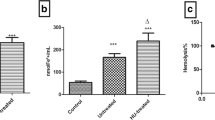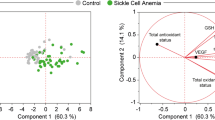Abstract
In the present study, we questioned the role of oxidative stress in hereditary spherocytosis (HS), where red blood cells (RBC) have a shortened survival due to primary deficiency in membrane proteins. Using flow cytometry techniques, we showed that RBC derived from 17 HS patients of seven families generate more reactive oxygen species, membrane lipid peroxides, and less reduced glutathione than normal RBC. Following in vitro incubation of HS-RBC from seven patients with a fermentation bioproduct of Carica papaya (fermented papaya preparation (FPP)) with known antioxidative properties, oxidative stress markers were significantly reduced. Similar results were obtained following treatment with FPP for 3 months of 10 adult HS patients, as well as decreased tendency to undergo hemolysis. The hemoglobin levels increased by >1 g/dl, mean corpuscular hemoglobin concentration decreased by >1 g/dl, and the reticulocyte count decreased by 0.93%. Concomitantly, lactic dehydrogenase decreased by 17% and indirect bilirubin by 50%. A significant decrease in malonyldialdehyde was also detected. These data indicate that oxidative stress plays an important role in the pathophysiology of HS which can be ameliorated by an antioxidant such as FPP. Additional clinical trials with FPP and other antioxidants are warranted.


Similar content being viewed by others
References
Cross CE, Halliwell B, Borish ET, Pryor WA, Ames BN, Saul RL, McCord JM, Harman D (1987) Oxygen radicals and human disease. Ann Intern Med 107:526–545
Halliwell B (1999) Antioxidant defense mechanisms: from beginning to the end. Free Radic Biol Med 31:261–272
Fibach E, Rachmilewitz EA (2008) The role of oxidative stress in hemolytic anemia. Curr Mol Med 7:609–619
Eber S, Lux SE (2004) Hereditary spherocytosis defects in proteins that connect the membrane skeleton to the lipid bilayer. Semin Hematol 41:118–141
Rocha S, Rebelo I, Costa LE et al (2005) Protein deficiency balance as a predictor of clinical outcome in hereditary spherocytosis. Eur J Haematol 74:374–380
Amer J, Goldfarb A, Rachmilewitz EA, Fibach E (2008) Fermented papaya preparation as redox regulator in blood cells of beta-thalassemic mice and patients. Phytother Res 22:820–828
Ghoti H, Rosenbaum H, Fibach E, Rachmilewitz EA (2010) Decreased hemolysis following administration of antioxidant—fermented papaya preparation (FPP) to a patient with PNH. Ann Hematol 89:429–430
Amer J, Ghoti H, Rachmilewitz E, Koren A, Levin C, Fibach E (2006) Red blood cells, platelets and polymorphonuclear neutrophils of patients with sickle cell disease exhibit oxidative stress that can be ameliorated by antioxidants. Br J Haematol 132:108–113
O’Connor JE, Kimler BF, Morgan MC, Tempas KJ (1988) A flow cytometric assay for intracellular nonprotein thiols using mercury orange. Cytometry 9:529–532
Bird RP, Draper HH (1984) Comperative studies on different methods of malondialdehyde determination. Methods Enzymol 105:299–305
Santiago LA, Osato JA, Hiramatsu M, Edamatsu R, Mori A (1991) Free radical scavenging action of Bio-catalyzer alpha.rho.No.11 (Bio-normalyzer) and its by-product. Free Radic Biol Med 11:379–383
Mansori A, Perry CA (1987) Hemoglobin autooxidation at physiological concentrations. Hemoglobin 11:353–371
Margetis P, Antonelou M, Karababa F, Loutradi A, Margaritis L, Papassideri I (2007) Physiologically important secondary modifications of red cell membrane in hereditary spherocytosis—evidence for in vitro oxidation and lipid rafts protein variations. Blood Cells Mol Dis 38:210–220
Becker PS, Morrow JS, Lux SE (1987) Abnormal oxidant sensitivity and beta-chain structure of spectrin in hereditary spherocytosis associated with defective spectrin-protein 4.1 binding. J Clin Invest 80:557–565
Snyder LM, Piotrowski Leb J et al (1983) Irreversible spectrin–haemoglobin crosslinking in vivo: a marker for red cell senescence. Br J Haematol 53:379–384
Osato JA, Korkina LG, Santiago LA, Afanas’ev IB (1995) Effects of bio-normalizer (a food supplementation) on free radical production by human blood neutrophils, erythrocytes, and rat peritoneal macrophages. Nutrition 11:568–572
Fibach E, Tan ES, Jamuar S, Ng I, Amer J, Rachmilewitz EA (2010) Amelioration of oxidative stress in RBC from patients with beta-thalassemia major and intermedia and E-betathalassemia following administration of fermented papaya preparation. Phytoterapy Res 24:1334–1338
Rachmilewitz EA, Weizer-Stern O, Adamsky K, Amariglio N, Rechavi G, Breda L, Rivella S, Cabantchik ZI (2005) Role of iron in inducing oxidative stress in thalassemia: can it be prevented by inhibition of absorption and by antioxidants? Ann NY Acad Sci 1054:118–123
Author information
Authors and Affiliations
Corresponding author
Rights and permissions
About this article
Cite this article
Ghoti, H., Fibach, E., Dana, M. et al. Oxidative stress contributes to hemolysis in patients with hereditary spherocytosis and can be ameliorated by fermented papaya preparation. Ann Hematol 90, 509–513 (2011). https://doi.org/10.1007/s00277-010-1110-2
Received:
Accepted:
Published:
Issue Date:
DOI: https://doi.org/10.1007/s00277-010-1110-2




